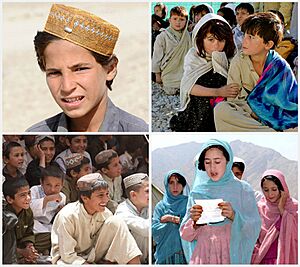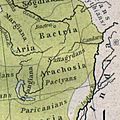Pashtunistan facts for kids
Quick facts for kids
Pashtunistan
پښتونستان
|
|
|---|---|

Pashtun-inhabited regions in green (1980)
|
|
| Countries | |
| Population
(2012)
|
|
| • Total | c. 42–50 million |
| Demographics | |
| • Ethnic groups | Pashtuns |
| • Languages | Pashto Minor: Persian, Urdu, Hindko, Balochi, Ormuri, Parachi, Dardic, Nuristani |
| Time zone | UTC+04:30 and UTC+05:00 |
| Largest cities | |
Pashtunistan (Pashto: پښتونستان, Pax̌tūnistān) means the "land of Pashtuns". It refers to the area where the native Pashtun people live. This region is found in modern-day Afghanistan and Pakistan.
Contents
Who are the Pashtun People?

The Pashtuns are the original people of Pashtunistan. They are also known as Pakhtuns or Pathans. They are an ethnic group with roots in Iran. Pashtuns are the largest ethnic group in Afghanistan. They are the second largest in Pakistan.
Where Pashtuns Live
Most Pashtuns live in the south and east of Afghanistan. Smaller groups are found in the north and west. In Pakistan, they live mainly in the west and northwest. This includes Khyber Pakhtunkhwa and northern Balochistan. You can also find Pashtun communities in other parts of Pakistan. These include Sindh, Punjab, Gilgit-Baltistan, and Islamabad.
Languages Spoken in Pashtunistan
The main language in the Pashtunistan region is Pashto. Other languages are also spoken there. These include Balochi, Hindko, Gojri, and Urdu.
Pashtun Culture and Traditions
Pashtuns follow a special code of conduct called Pashtunwali. This is their traditional way of life. It is very important to many Pashtuns. It helps keep their identity strong. This cultural code existed even before Islam came to the region.
The Pashtun lands are divided by a border called the Durand Line. This line separates Pakistan and Afghanistan. However, many Pashtun tribes used to cross this border easily. They would visit family or attend tribal meetings called jirgas. After military actions in the area, it is now harder to cross the border.
Pashtun Population Numbers
Pashtuns make up a large part of Afghanistan's population. They are about 42-60% of the people there. In Pakistan, they are about 15.42% of the 200 million people. This number does not include Pashtuns living in other Pakistani cities. In Pakistan's Khyber Pakhtunkhwa Province, over 73% of people spoke Pashto in 1998.
Images for kids
-
Coronation of Ahmad Shah Durrani in 1747. This painting is by a 20th-century Afghan artist, Abdul Ghafoor Breshna.
-
King Amanullah Khan, a leader in Afghanistan's history.
-
Bacha Khan (left) with Mahatma Gandhi and Kasturba Gandhi.
-
Ayub Khan, who was President of Pakistan from 1958 to 1969. He belonged to the Pashtun Tareen tribe.
-
Kalam, a beautiful place in Swat District in Khyber Pakhtunkhwa, Pakistan.
-
A village in Kunar Province of Afghanistan.
-
A view from Nangarhar Province, Afghanistan.
-
A village in Khost Province, Afghanistan.
-
The shrine of Hassan Abdal in Kandahar Province in Afghanistan.
-
Asadabad, the capital of Kunar Province in Afghanistan.
-
Branches of the Kunar River meet in Nangarhar Province.
-
The Kabul River in Jalalabad, Afghanistan.
-
The famous Khyber Pass in Khyber Pakhtunkhwa, Pakistan.
-
People attending Khost University in Khost, Afghanistan.
-
A scene from Ghazni Province, Afghanistan.
-
Afghan Border Police (ABP) in Paktika Province.
-
Kuchi people, who are nomads, in Paktia Province of Afghanistan.
-
Hanna Lake in Quetta, Pakistan.
-
Dahla Dam in Kandahar Province.
-
The Arghandab River Valley in Kandahar Province, Afghanistan.
-
The Helmand River in Helmand Province, Afghanistan.
See also
 In Spanish: Pastunistán para niños
In Spanish: Pastunistán para niños

























